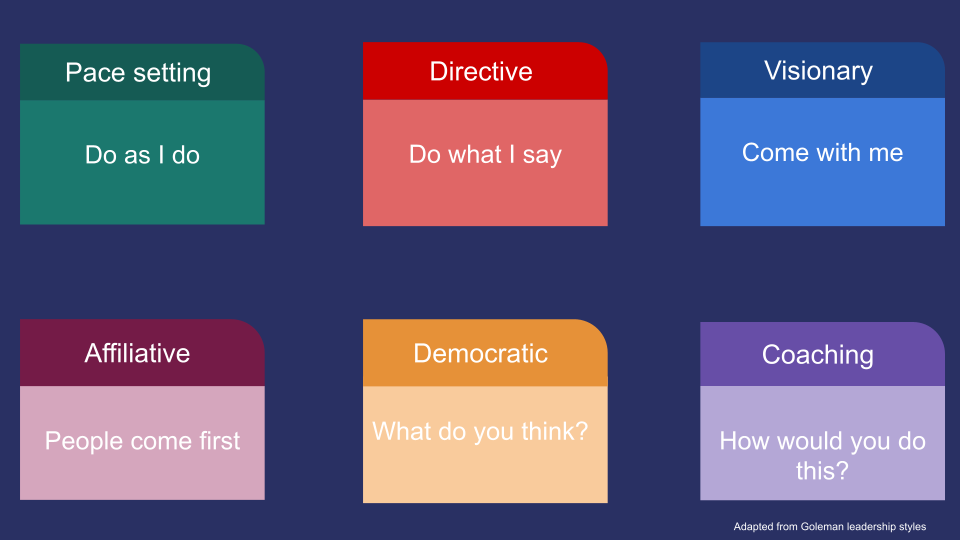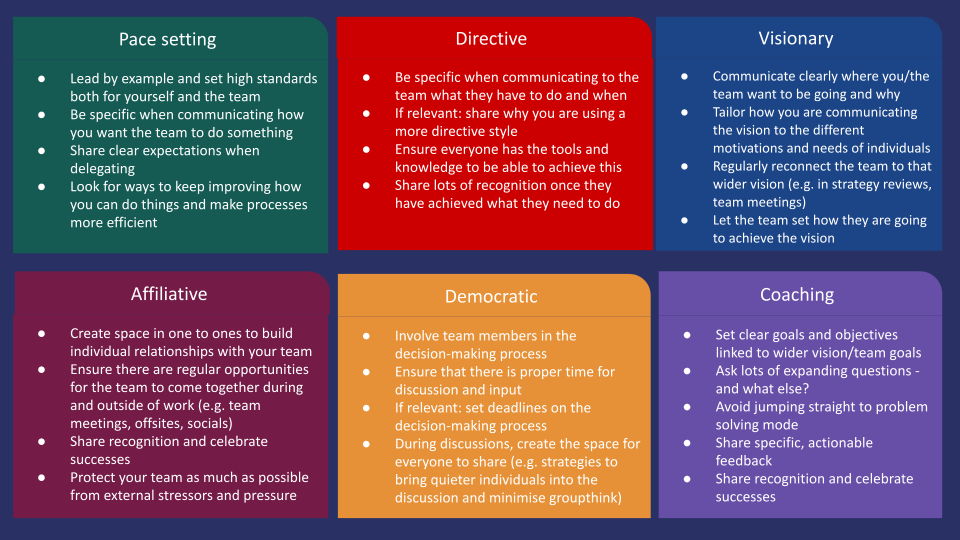10th January, 2024 • 5 minutes

Written by Eloise Barbier
28th February, 2024 • 5 mins

Is there one type of leader that you should aspire to be?
There are common associations and expectations around leadership, which can make it feel challenging or inaccessible if we don’t think we align with these expectations. A more useful, authentic approach is to consider how we are adapting our leadership style based on the context and individual. This is known as situational leadership.
There are many tools and approaches that can help us adapt our leadership style. A useful starting point is the six Goleman Leadership Styles.
Each style has strengths and risks associated with it. While we will often gravitate towards one or two more organically, the aim is to use all of these styles in different quantities, and move between them based on the situation.
What are the benefits of adapting your style as a leader?
For ourselves as leaders: it increases our self awareness by understanding which styles we use the most, and provides direction and context to adapt how we lead.
For our team: we can better adapt to our team’s needs and motivators, and clearly share expectations based on what the situation requires.
The six leadership styles

1. Pace setting
“Do as I do now” – you demonstrate and role model the behaviour(s) you want to see. You set the pace in the team by doing the doing.
When to use this style
Risks of only using this style: you are doing the doing so you have less headspace to step back, reflect and take a more high level perspective. It also does not encourage your team to be autonomous and develop their own approaches. This could restrict innovation and problem solving in the longer-term.
2. Directive
“Do as I say” – you tell the team what they need to do and when to do it. You set a clear objective and ensure everyone knows exactly what they have to do.
When to use this style
Risks of only using this style: this style can easily be used too much. It can disengage the team as it removes all autonomy (which is a core human motivator), and can feel overbearing or like “micromanaging”. It also creates less connection to the bigger picture and why the team is doing what they need to do, which is demotivating in the long-run.
3. Visionary
“Come with me” – inspiring and motivating people to work towards a long-term vision. You share the vision and long-term strategy and bring your team on the journey.
When to use this style
Risks of only using this style: if you only share the vision the team can lack the detail and practical plan of what is needed to achieve the vision. This may lead to a lack of clarity in how to move forward, a mismatch in expectations, or people getting demotivated as they don’t know which way forward is best.
4. Affiliative
“People come first” – focusing on team wellbeing, relationships and harmony. You actively create a space where team members feel comfortable communicating, and focus on inclusion.
When to use this style
Risks of only using this style: results and performance can get sidelined, which may lead to lower performance not being addressed and goals being missed. In this style you are also focused on keeping everyone happy, which may lead to a lot of compromise and not be sustainable in the long-term where decisions need to be made and change might have to happen.
5. Democratic
“What do you think?” – working together through dialogue and getting input from everyone in the team. You involve your team in the decision-making process and gather all their ideas.
When to use this style
Risks of only using this style: taking a democratic approach is time consuming, so not useful when you need to make a quick decision or guidance is urgently needed. If your team is not informed enough on the situation or context, this will not lead to effective decision-making as they won’t have enough information to share good ideas.
This style will also not be effective when a change or decision has been made and you need people to come on the journey rather than challenge the decision.
6. Coaching
“How would you do this?” – asking questions and developing your team for the future. You ask your team how they would do something and guide rather than just telling them how to do it.
When to use this style
Risks of only using this style: it is less effective in situations where we need to take a more direct approach (we need fast results or to act quickly). Or when managing someone who needs a lot of direction and feedback, and is not ready yet to be coached.
Reflect on your leadership style
How to dial up the leadership styles

In summary
1. Keep these leadership styles front of mind when leading and consider how you are adapting to the context and individual
2. Reflect on your “baseline” – which style(s) you gravitate towards the most organically
3. Depending on the situation, set actions around which styles you want to dial up or down and how you will do this
If you would like to find more about the transformational leadership programmes we run at Higson please get in touch, we would love to hear from you.